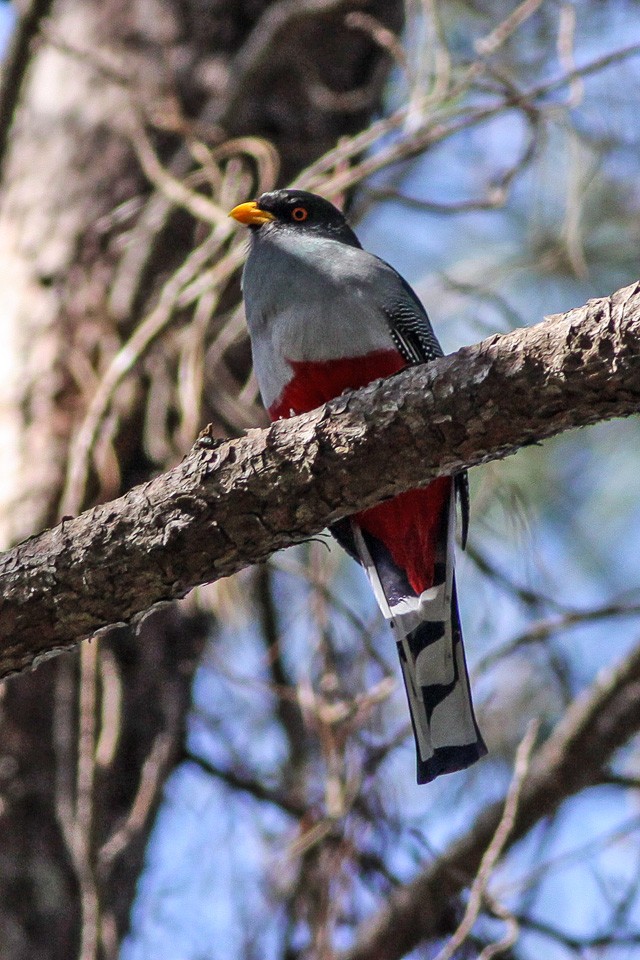Hispaniolan Trogon
A species of Antillean Trogons Scientific name : Priotelus roseigaster Genus : Antillean Trogons
Hispaniolan Trogon, A species of Antillean Trogons
Botanical name: Priotelus roseigaster
Genus: Antillean Trogons
Content
Description General Info
 Photo By Ron Knight from Seaford, East Sussex, United Kingdom , used under CC-BY-2.0 /Cropped and compressed from original
Photo By Ron Knight from Seaford, East Sussex, United Kingdom , used under CC-BY-2.0 /Cropped and compressed from original Description
The Hispaniolan trogon (Priotelus roseigaster) is a species of bird in the family Trogonidae. It is the national bird of Haiti. It is endemic to Hispaniola (Haiti and the Dominican Republic) in the Caribbean. It is one of the only two trogon species found in the Caribbean. Its natural habitats are subtropical or tropical moist montane forests, and heavily degraded forest. It is threatened by habitat loss. It is mostly confined to a few remaining protected areas. 
Size
30 cm
Nest Placement
Tree
Feeding Habits
Hispaniolan Trogon predominantly feeds on insects, fruits, and occasionally, small vertebrates like anoles. Hispaniolan Trogon follows typical trogon feeding behavior, which includes sallying from perches to catch prey mid-air or foraging in foliage.
Habitat
Hispaniolan Trogon predominantly inhabits montane and lowland forests, including rain, dry, and pine forests as well as broadleaved deciduous woodlands. This species can be found across a range of elevations, extending up to 3000 meters. Although there are historical accounts of hispaniolan Trogon in mangrove swamps, the regularity of this occurrence and whether these swamps are part of its typical habitat range remain uncertain.
Dite type
Omnivorous
General Info
Feeding Habits
Bird food type
Behavior
Its foraging behaviour is presumed to be similar to that of other species of trogon: most food is taken in aerial sallies to fruit or to surrounding vegetation. The species primarily forages in the midstory of humid deciduous and pine forests. A study of mixed-species flocks on Hispaniola recorded two encounters with the Hispaniolan trogon, both of which were associated with mixed flocks. 
Species Status
The Hispaniolan trogon is a forest-dependent species, and is vulnerable to habitat loss or degradation The IUCN Red List conservation status of the Hispaniolan trogon is assessed as Near Threatened, because its population is continuing to decline throughout its small range, owing to forest degradation and fragmentation. Forest loss and fragmentation owing to shifting agriculture are causing a decline, particularly in moist forest areas. Dry forests have been considerably altered by charcoal production, and pine forests have been reduced as a consequence of indiscriminate logging and clear-cutting. In particular, recent habitat destruction along highways has caused a drastic decline of the population in the Cordillera Central, but it is occasionally seen on abandoned coffee farms and old cocoa groves in the Cordillera Septentrional. The species is also subject to hunting. However, as the range is relatively wide and not yet severely fragmented, the species is classified as Near Threatened. Some populations are afforded protection by national parks, such as in the Sierra de Baoruco. Proposed conservation actions include monitoring the population regularly, effectively protecting national parks that hold populations of the species, encouraging forms of agriculture which do not require forest clearance, discouraging charcoal production in native forests, and raising awareness of the uniqueness of the species, as well as discourage hunting. 

 Photo By Ron Knight from Seaford, East Sussex, United Kingdom , used under CC-BY-2.0 /Cropped and compressed from original
Photo By Ron Knight from Seaford, East Sussex, United Kingdom , used under CC-BY-2.0 /Cropped and compressed from original Scientific Classification
Phylum
Chordates Class
Birds Order
Trogons Family
Trogons and quetzals Genus
Antillean Trogons Species
Hispaniolan Trogon